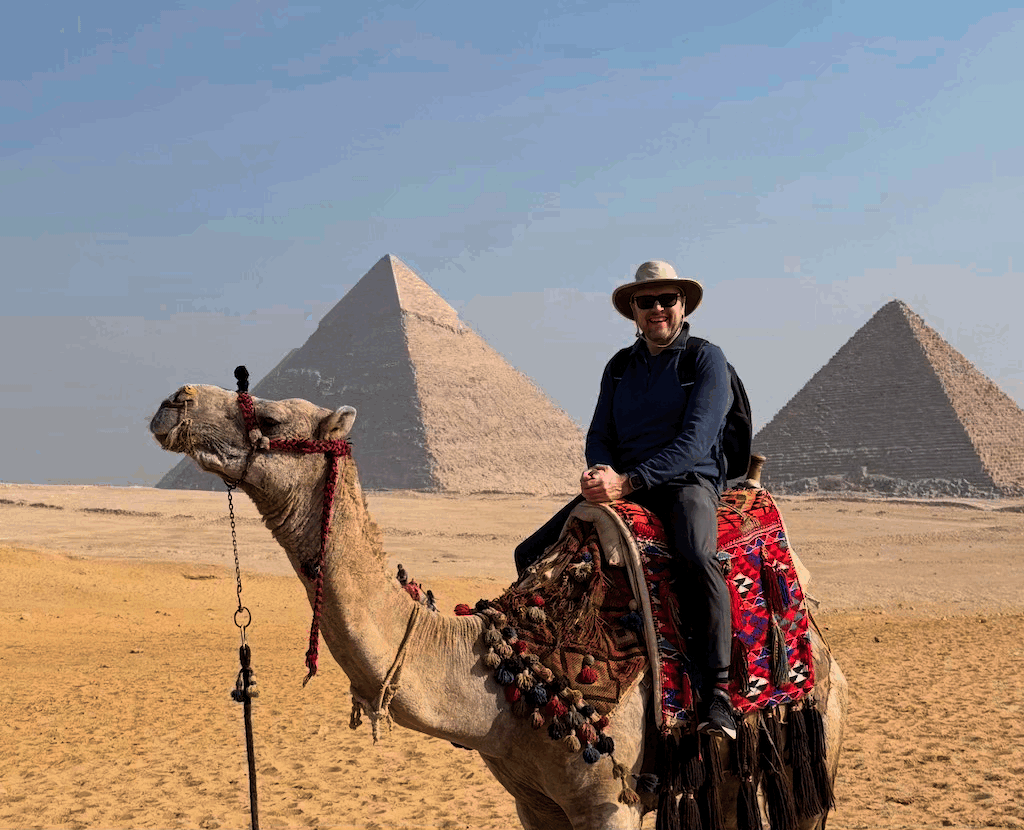Kristin and I spent 13 days in Egypt this January, staying at hotels in Cairo, Aswan and Luxor, and with a four day cruise down the Nile. It was definitely a once-in-a-lifetime trip that lived up to our high expectations, with incredible sites, history, food, people, and experiences. Here is our travel log:
Day 1: Boston
Egypt has been a dream trip for Kristin since she was a child (all Gen Xers can blame Scooby Doo). While we have talked about going several times over the years, we just never felt it was the right time. It wasn’t even on our radar for 2025 until one night on Cape Cod this summer. I should start with a disclaimer: Kristin swears she does not remember this story as I tell it.
On a beautiful August evening, Kristin and I sat down to watch TV with a glass of wine. It had been a very hot day, and I’d done a long outdoor walk and a HIIT session at the gym that afternoon. The sun setting over the cove was shining through our sliding glass doors, so I got up to close the blinds. As I started to close them, everything went dark and the next thing I remember was waking up on the floor with Kristin looking over me. My recollection is she shouted at me in an angry tone: “You have to see a cardiologist!” - but again, she claims not to remember this. 😉
In checking my heart rate, it was scary low, and I suggested we go to the emergency room. On the drive, I started to tell Kristin all the things I would want her to know / do if something unexpectedly happened to me, which only served to freak her out even more. My recollection is she said: “If something happens to you before I see the pyramids, I will be so mad!”
After an EKG, wearing a heart monitor, and having an echocardiogram, the medical diagnosis came back: I was dehydrated. A couple bags of IV fluids later, I felt fine and they sent me on my way with a bruised ego and… a sudden desire to go to Egypt.
Our flight from Boston to Cairo via Munich didn’t leave until 8:30 PM, so Kristin and I spent most of our first day making minor changes to our luggage. In the evening we Ubered over to Logan Airport with that mix of excitement and anxiety that comes with leaving home, and waited in the Lufthansa lounge for our flight to board. Before we knew it, our plane was taxiing down the runway and we were on our way to Egypt.
Day 2: Cairo
We spent most of the day traveling to Cairo via Munich. It was a long day that felt longer due to the lack of sleep and the seven hour time change. We arrived in Cairo in the evening, where we were transported to the Mena House in Giza, a former 19th century hunting lodge located right next to the pyramids. The drive to Giza took about an hour, and we passed through neighborhoods with modern buildings and bright lights and others that looked dark and rundown.

After checking in and getting settled in our room, we had a little energy left and decided to visit the hotel's 24x7 restaurant: 139 Pavilion. As we walked through the gardens toward the terrace by a large fountain, we noticed something large looming just beyond the walls of the hotel. It took us a few seconds to realize it was the Pyramid of Khafre, the second largest in Egypt. This was one of those moments neither of us is likely to forget. It was hard to deny: we really were in Egypt.
Day 3: Giza
After breakfast our guide took us around the Giza plateau to see the three main Old Kingdom pyramids (Kufu, Khafra and Menkare) and the three queen pyramids. We actually went inside the Great Pyramid to see the King’s Chamber and the Grand Gallery, which required working through hot, steep and cramped passageways, including a few where we had to crouch the entire way. After that we went to one of the panoramic views further out in the desert to take some photos and ride camels, and then toured the Sphinx complex. We debated whether or not to ride camels after reading many articles about their poor care, but our guide assured us his preferred vendor was highly reputable. On our way home we made a stop at a papyrus store, where we sipped Turkish coffee while learning how plants were turned into the first paper in human history. This was our first introduction to “educational tours,” which I will discuss in more detail later. Overall it was a great start to our 1st full day in Egypt.
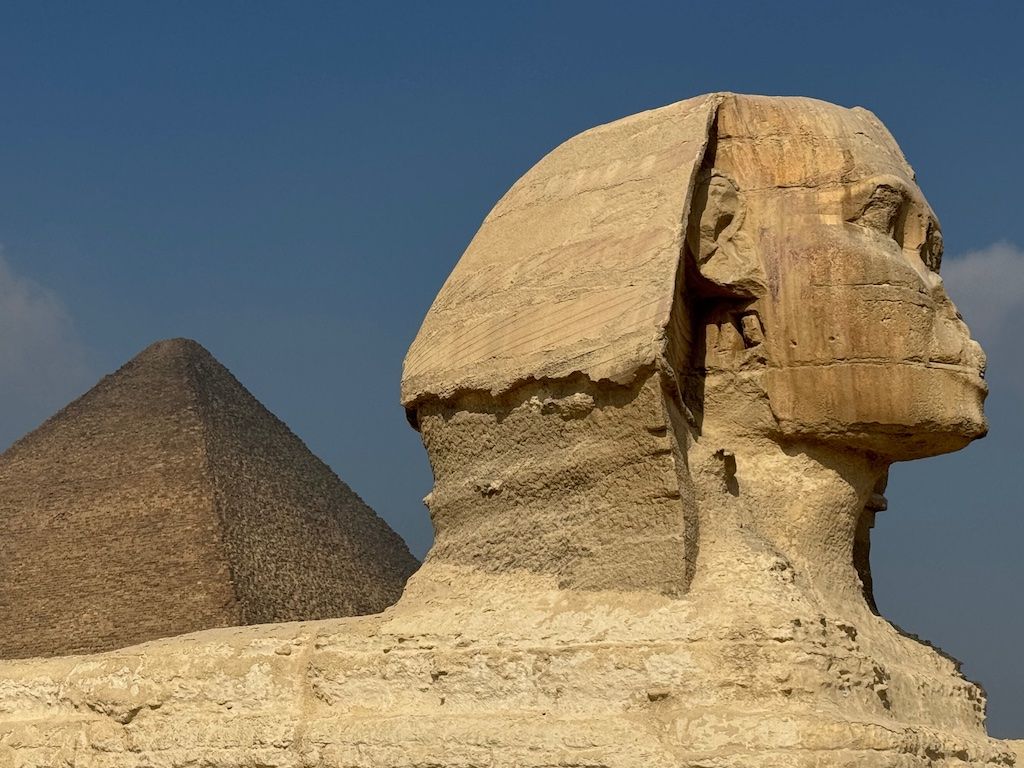
I read a lot about the traffic in Cairo before coming here, but nothing quite did it justice. The lanes are only recommendations for drivers, so cars go wherever they want. Many of the drivers honk their horns almost continuously to let others know they are there. Our guide said the first two things an Egyptian looks at in buying a car are the brakes and horn, and if they aren’t in good condition, they don’t bother to look at the rest. But even scarier than driving is crossing the street, since stop lights and crosswalks are nonexistent. On our way to Giza last night, I watched people nonchalantly cross a 12 lane highway in the dark as cars whizzed by. Our travel coordinator told us that if we have to cross a busy street, to just follow an older Egyptian man. Apparently he trusts them based on the fact they have survived for so long.
Day 4: Memphis, Saqqara & the GEM
Today we went to Seqqara, Memphis and the new Grand Egyptian Museum (GEM) in Giza. Seqqara is an ancient burial ground created during the Old Kingdom (2649-2130 BCE), and best known for the Step Pyramid of King Djoser. Prior to this king, all the tombs were what were called mastabas, which were single story stone or mud brick structures that were on top of catacombs dug into the bedrock. King Djoser’s architect had two innovations that made possible the later pyramid age: 1) stacking a series of successively smaller mastabas on top of each others, forming a pyramid-like shape, and 2) creating a Vatican-like walled complex around the pyramid made up of temples and buildings to celebrate the king after his death. The Step Pyramid would become the first multi-story stone structure in human history, and within 80 years would make possible Khufu’s Great Pyramid (2.2M+ stone blocks and 480 feet high).
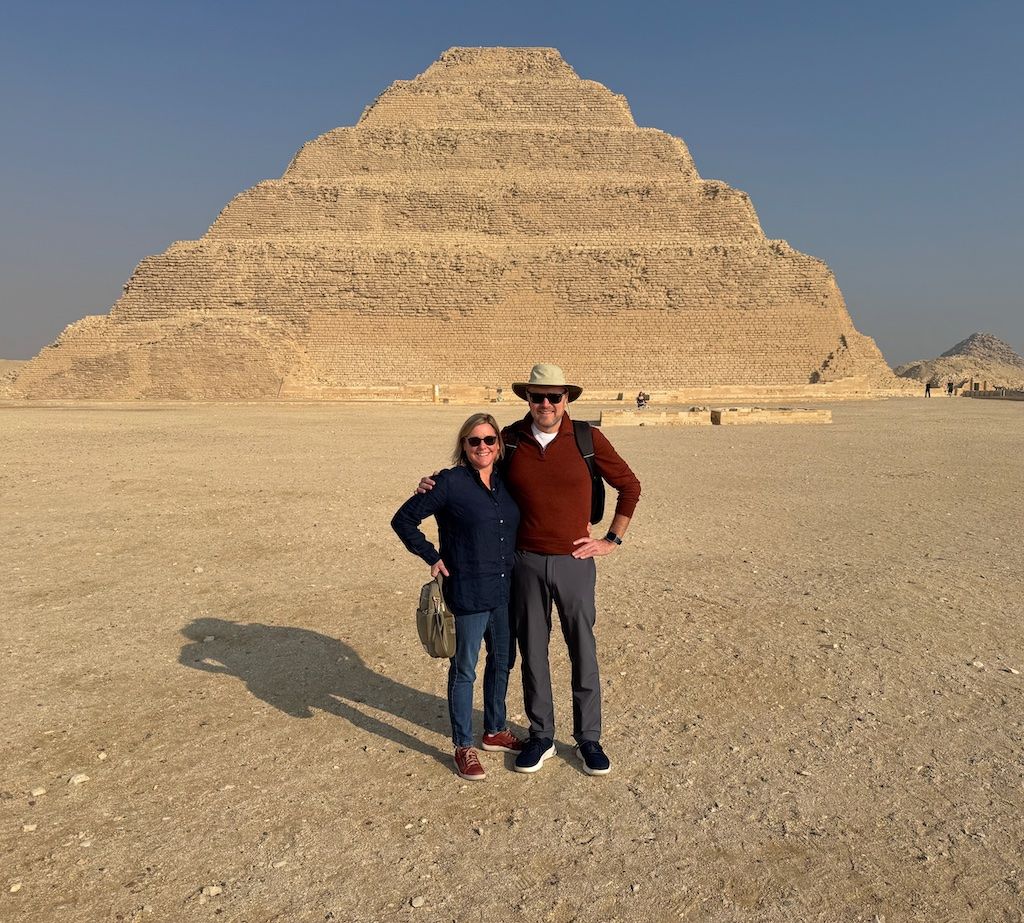
Memphis was the first capital of ancient Egypt, founded with the 1st dynasty, but used throughout all ages of ancient Egypt. All that is left today are ruins, with most of the site still left to be excavated. The most dramatic site was the statue of Ramses II, which was one of the greatest kings of Egypt during the New Kingdom.
We ended our day at the Grand Egyptian Museum, which has been a 20+ year project that reminds me of Boston’s Big Dig (substantially over budget and timeline). The first 12 galleries opened this year, so we were fortunate to be able to see it. After passing a majestic statue of Ramses II in the atrium, you climb a series of wide staircases that give you the sensation of going up a pyramid, with statues from different ages along the way. At the top it opens to big windows that overlook the pyramids of the Giza plateau. The exhibit halls then take you on a chronological tour through ancient Egypt, starting in the predynastic period and ending with the Greek and Romans period. Even in its unfinished state, it really is an incredible museum.
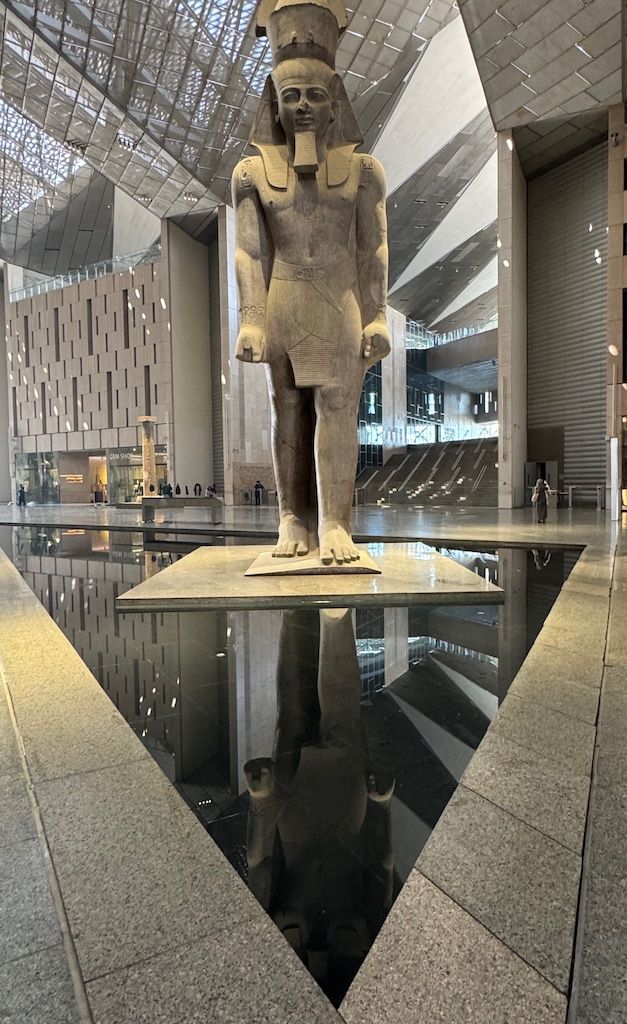
Day 5: Aswan
After breakfast we headed back to the Cairo airport to catch an EgyptAir flight to Aswan, which is in the far south of the country. This was the first of several EgyptAir flights we would take on our trip, all of which were delayed for reasons never explained. After a 90 minute flight, we arrived at the Aswan airport, where we were shuttled to our hotel: the Old Cataract.

The Old Cataract is a historic luxury hotel that overlooks the Nile, with stunning views of Elephantine Island. Built in 1899 at the location of what was once the first cataract in the river, it blends Victorian grandeur with Arabian design. It has had many famous guests over the years, from Winston Churchill to Princess Diana to Tsar Nicholas II. But what drew us to this hotel was a combination of its history and Kristin’s passion for mystery novels. In the 1930s, Agatha Christie’s stay here inspired her to make this a setting for her book “Murder on the Nile.” We were really looking forward to going on a 4 PM tour that includes a visit to her suite, but unfortunately we missed it due to our delayed flight. After hearing our story, Sinwar from guest relations offered to give us a personal tour. Between our entree and dessert, he snuck us up to her suite, which included a living room, dining room, bedroom, bathroom and office. Even though I’ve never read an Agatha Christie novel, I still thought it was a cool experience.
Across from the Old Cataract is Elephantine Island, which contains an archeological site that spans many different time periods of Egyptian history. It includes the ruins of the Temple of Khnum, which was rebuilt in the 2nd or 3rd century BCE over a previous temple that dated back 4,600 years ago. The god Khnum is one of the oldest in Egyptian mythology, first known to appear in the predynastic period 5,000+ years ago. He was responsible for regulating the annual flooding of the Nile, which raised water levels by 30+ feet and flooded the land in Lower Egypt for 3-5 miles on either side of the Nile. Today the water level is kept stable by the Aswan High Dam. In the low season before the dam, the water level would have been 30-50 feet lower than what we see today.
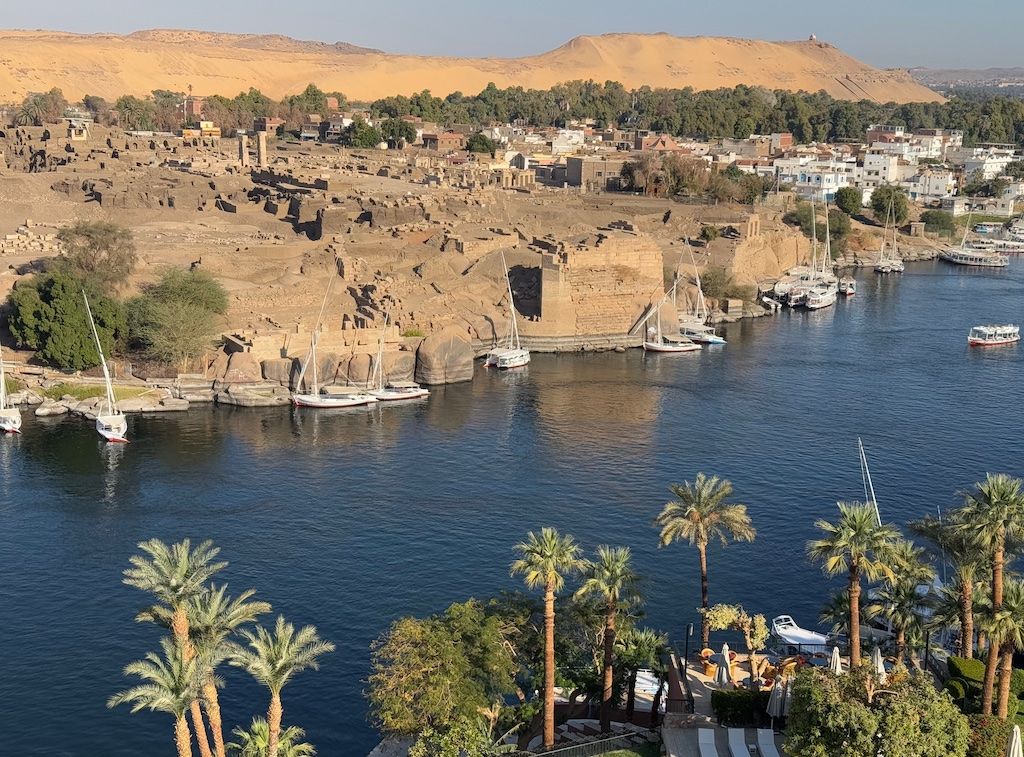
This site also has an ancient Nileometer, which was used the measure the annual inundation. These came in different forms - wells, stairways or sloped channels. The one on Elaphentine Island is a stairway that goes into the water, with the number of steps covered by water used to measure the annual flooding. The rulers of ancient Egypt used this measurement to predict the harvest, to prepare for flooding, and to determine the taxes to be levied on the people.
Day 6: Abu Simbel
Today we did a day trip to Abu Simbel to see two temples built by Ramses II in the 13th century BCE. One temple is dedicated to Ramses and the other to his wife, Queen Nefertari. But in classic Ramses fashion, he put four statues of himself beside two of his wife’s outside Nefertari’s temple. Both temples were carved from a limestone mountain along the Nile in what was then Nubian land - a not so subtle reminder to the inhabitants of the power of Egypt.
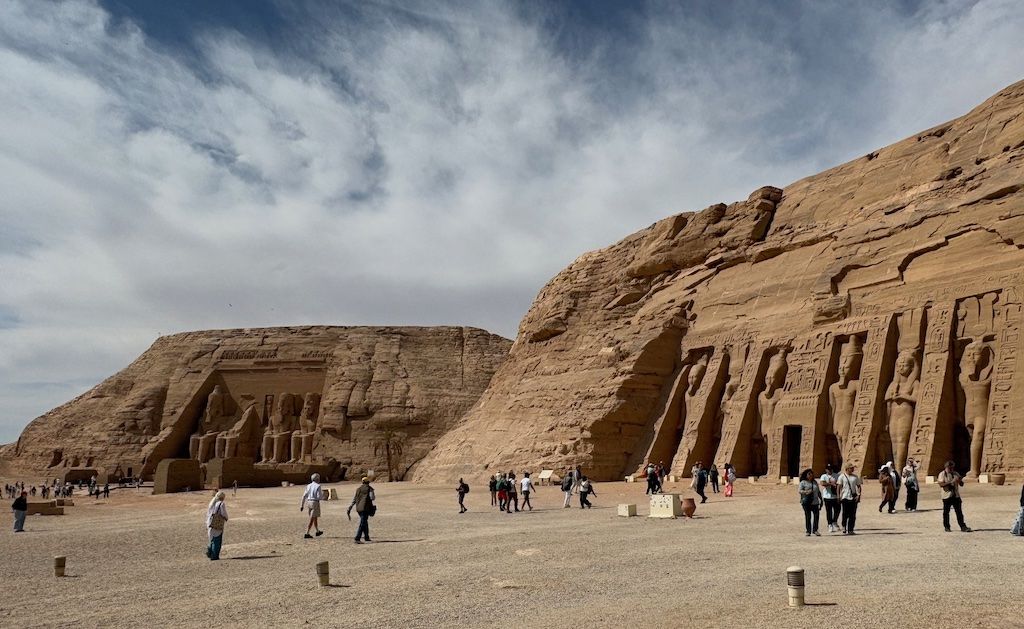
Ramses II was the longest reigning king of Egypt (1279-1213 BC), dying of natural causes in his 90s. I’m not sure if it was the length of his rule or that he had a great brand manager, but we have seen more statues of him than any other pharaoh. In addition to building lots of temples and statues dedicated to himself, he also took the time to put his name on the works of other kings. As best I can tell, he was also the first photo bomber in history, which you can see in a photo of a statue of the trinity of gods for Memphis at the GEM, which normally would show Ptah (creator god, always bald), his wife Sekmet (goddess of war, lioness head), and their son Nerfertum (god of healing). Who is it that magically appears between Ptah and Sekmet? Yes, it is none other than the Taylor Swift of pharaohs, the totally over-exposed greatest pre-social media influencer in history: Ramses II.
You can fly or take a bus to get to Abu Simbel. It is a three hour bus ride across the Sahara, with vehicles required to go in convoys led by police escorts (for what everyone insists is not security concerns). We went by plane, which took only 30 minutes, and was definitely the best way to travel.
With the construction of the Aswan High Dam in the 1960s, the water levels of the Nile rose to form Lake Nasser, the largest manmade lake in the world. When it was realized the rising water was going to submerge Abu Simbel, UNESCO organized an emergency relocation project that involved 50 countries. The project disassembled the mountain and temples, and reassembled them on ground 200 feet higher and 600 feet to the west. This site is now a UNESCO World Heritage Site, and is fully restored to its 13th century BCE grandeur. They even left the eroded head of one of Ramses statues exactly where it fell in an earthquake from antiquity.
After returning to the Old Cataract, we had just enough time to eat takeout koshari before hopping on a felucca to sail with a guide to Kitchener's Island, a botanical garden on the Nile. Unfortunately there was no wind, so if not for a tow from a motorboat, we would still be drifting on the Nile right now. We passed a Nubian village and watched several young kids on their paddle boards hitching rides on passing boats. This was our first real chance to catch a glimpse of life on the Nile. We will get a lot more of this tomorrow since we head out on a cruise to Luxor.
There was definitely a little Indiana Jones vibe going on today. I’m not sure if it was waking up at a hotel that looks straight out of the 19th century, or walking down the darkened passageways of an ancient temple underneath giant statues, or landing in a hot dusty airport in the middle of the Sahara - but this day definitely felt pretty exotic. To recover, Kristin and I are sitting on the balcony drinking Egyptian wine and watching the boats on the Nile pass by.
Day 7: Cruising
Today we transferred to the MS Sonesta Sun Goddess, a cruise ship which sets sail while we are sleeping tonight. While the ship is still docked, we made an afternoon visit to the Aswan High Dam, which was built in the 1960s to control the flooding of the Nile. We also took a boat over to Philae Temple, which was built in the 5th or 6th century BCE during the Ptolemaic times. I was surprised by how incredibly uninteresting our journey was to the dam, but the visit to Philae was excellent.
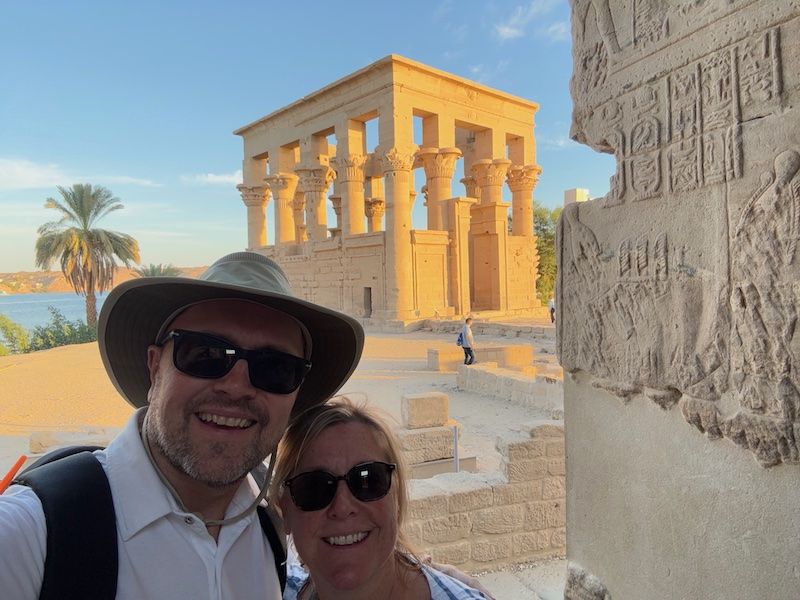
While this trip has been absolutely fantastic so far, I do have one small complaint to register about traveling to Egypt: baksheesh. Depending on how you count it, tourism accounts for 8-24% of Egypt’s GDP, making it by far the top industry in the country. The result is that Egyptians seem to have found every possible way to generate money from tourists. E.g. if an armed policeman waves you over and offers to take a photo for you, he is expecting a tip; if you use a public restroom, there will be an attendant asking you for money; if you accidentally follow someone waving you into a tomb, he is trying to lure you on a tour in order to get a tip.
Even the private tour guides schedule shopping excursions into their itineraries, which they shamelessly present as “educational opportunities” - e.g. learn how they make papyrus, watch Egyptian rug making. These are of course really just opportunities to bring tourists to local businesses from which the guide gets a cut on sales.
I have reminded myself that these people are just trying to make a living - and that for the most part, the tips are not large by American standards. But the overall volume of tipping (I have tipped eight times today on what is supposed to be an all inclusive cruise) definitely detracts a little from the experience. There was a moment this afternoon where I felt like the busiest ATM in Aswan.
Rant over. Time to enjoy a glass of Egyptian wine in the lounge. No tipping required… I think.
Day 8: Cruising
We woke up this morning cruising down the Nile. After docking our guide took us to the Komobmo Temple, which is unique in Egyptian history since it is dedicated to two gods: Sobek, the crocodile god, and Horace, the falcon-headed god. While I have a basic understanding of Egyptian history, the 400+ gods are a constant source of confusion for me.
This temple was built during the Ptolemaic dynasty around the 1st or 2nd century BCE, and has a symmetrical design, with the right side for Sobek and the left for Horace. We also went in the crocodile museum, which is filled with mummified crocodiles found at the site. Kristin was particularly impressed with this temple.
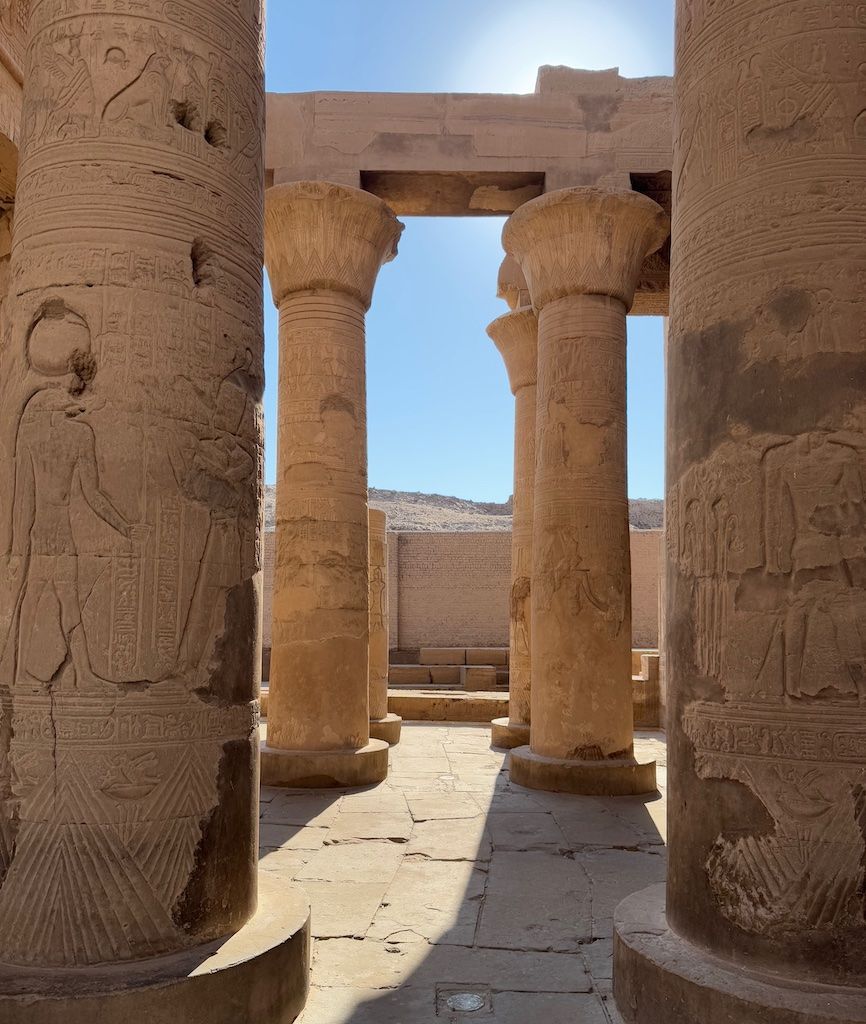
We then re-boarded the ship to cruise further down the Nile, docking again in the afternoon in order to visit the Temple of Edfu. The temple was about a mile from the docks, so we went by horse and buggy. Edfu built in the 3rd century BCE and dedicated to the god Horace, the son of Isis. It is one of the better preserved ones in Egypt, due partly to its late construction but also because parts were covered by mud and sand for many years. The walls were over 90 feet high, and the wooden gates that once hung at the entrance were over 60.
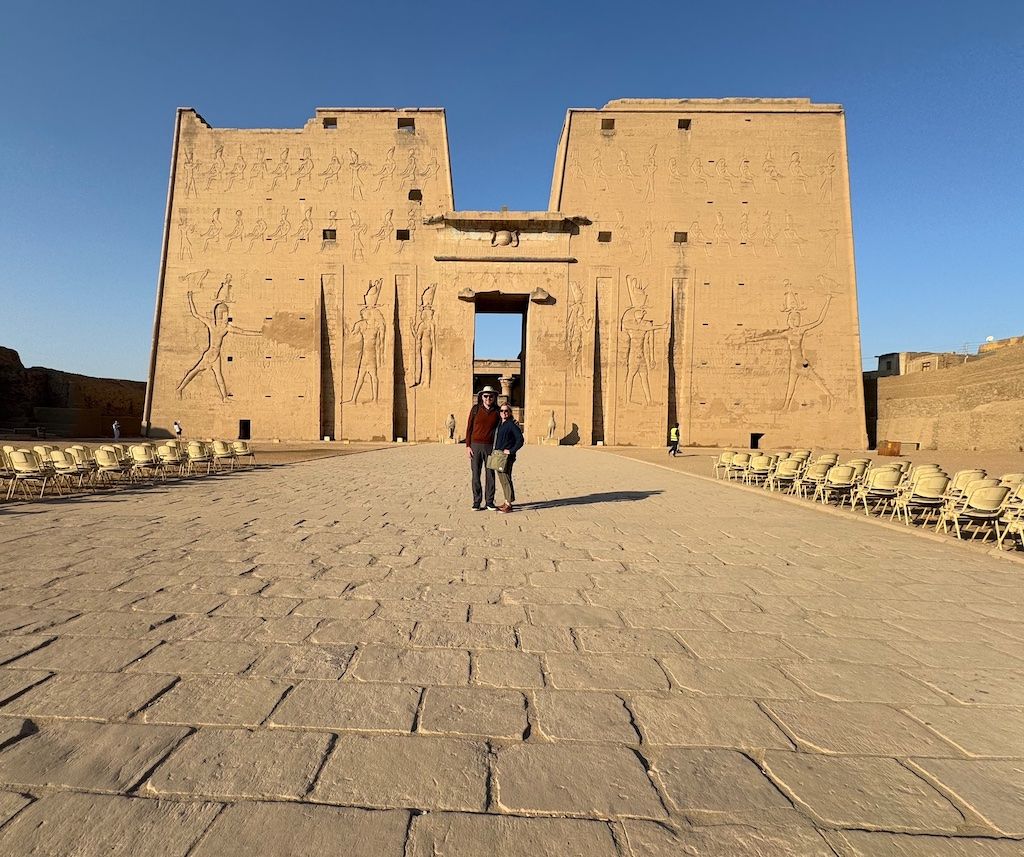
Unfortunately many of the carvings in the temple were defaced by either Christians or Muslims in later years. Kristin was collecting photos of bird carvings, and we went on a mission to find an owl that had not been defaced. On the second to the last inner chamber - a section that had clearly been buried longer - we found several intact owls.
Day 9: Luxor
Our ship arrived in Luxor as the sun was coming up and we watched from our balcony as hot air balloons floated across the Nile. The cruise gave us a 6 AM wake up call and our guide made sure we were out the door by 7 AM. We made four stops over the next five hours: Temple of Hatshepsut, Valley of the Kings, the Valley of the Queens, an alabaster shop, and the remains of the mortuary temple for Amenhotep III.
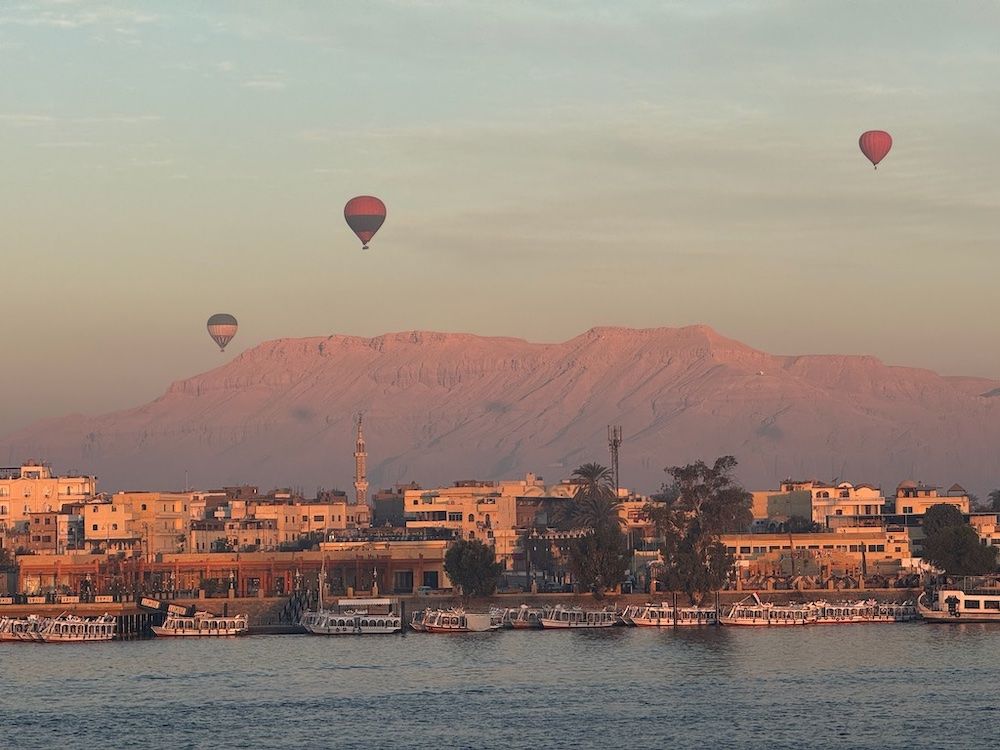
The Temple of Hatshepsut was built into the same mountain as the Valley of the Kings and Queens but on another side. When Hatshepsut‘s husband died early, the only heir to the throne was a young boy that was the child of one of the other wives. As the queen, she agreed to serve as the regent until the boy reached adulthood. But when the time came for her to relinquish power, she decided instead to make herself pharaoh.
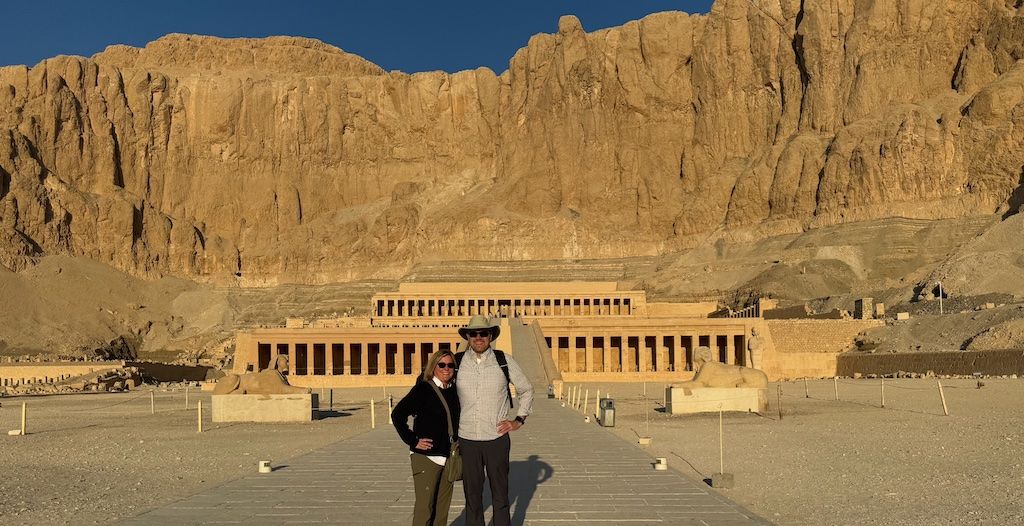
Hatshepsut (1479-1458 BCE) would rule for about 22 years and was known for bringing great prosperity to Egypt through trade, monumental building, and peace. She had herself portrayed in statues and paintings as a male pharaoh, even wearing the traditional false beard. Her majestic mortuary temple is architecturally unlike anything else in Egypt, with a multi-level front entryway leading to chambers built into the limestone cliff.
Her step-son, Thutmose III, eventually gained power and attempted to erase her legacy by defacing her statues and replacing her cartouches and inscriptions. She was even eliminated by scribes from king lists. But we are fortunate that her story and her temple have survived.
Next we headed over to the other side of the mountain to visit the Valley of the Kings. In ancient Egypt, the east bank of the Nile was for the living and the west bank was for the dead. Luxor is located on the east bank and the Valley of the Kings is on the west. Amenhotep I was the first king to build a tomb here 3,500 years ago. By the New Kingdom, the pharaohs realized pyramids were not safe from tomb robbers. Amenhotep’s innovation was to build his mortuary temple into the limestone of a mountain whose peak looked like a pyramid. Unfortunately this innovation wouldn’t prove to be any safer since all but one of the 63 tombs was found empty.
We went into three tombs in the Valley of the Kings: Ramses III, Ramses IV, and Ramses IX. The wall paintings were in surprisingly good condition, with vibrant colors and stunning artistry. It’s hard to believe these were done 3,000+ years ago. I told Kristin that we need to find an ancient Egyptian to paint our house.
When our guide told us going inside King Tut’s tomb required purchasing separate tickets, I said we weren’t interested since we were seeing his treasures at the Egyptian Museum in Cairo. I was however quickly corrected by Kristin, who wasn’t leaving the Valley of the Kings without seeing King Tut’s tomb. While the tomb was small and unfinished due to his untimely demise, the wall paintings were among the most vibrant we had seen in either the Valley of the Kings or Queens. His mummy is located in an enclosed glass container inside the tomb, making him the only king of ancient Egypt to still reside in his burial chamber. I am glad Kristin corrected me.
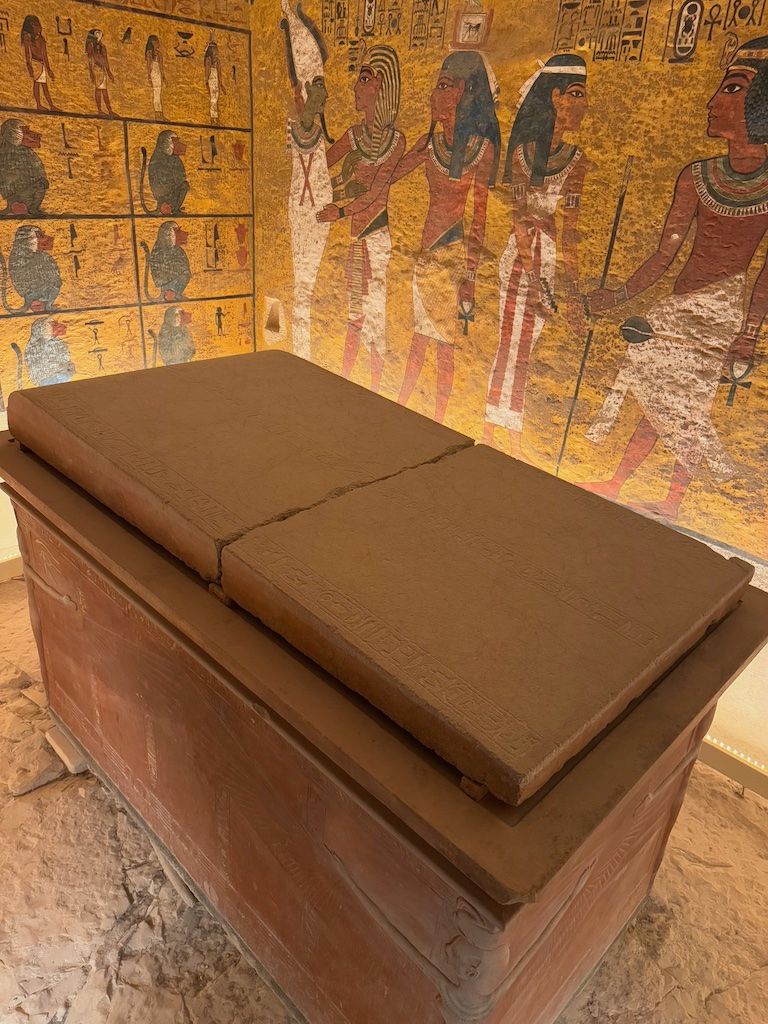
We ended the morning with a visit to the Valley of the Queens, which is where queens and the direct family of the kings were buried. Before returning to the ship for lunch, we stopped to see the giant statues of Amenhotep I, which due to erosion from the Nile is all that remains of his mortuary temple.
After lunch on the cruise ship, we headed back out for a long afternoon. The mic drop for the day came from our afternoon visit to the Temples of Karnak and Luxor. I had heard Karnak described as the Vatican complex of ancient Egypt, first built in the Middle Kingdom over 4,000 years ago and expanded over the next 1,300 years. It spans over 240 acres and is connected to Luxor Temple by a recently discovered sphinx-lined avenue that spans almost two miles.
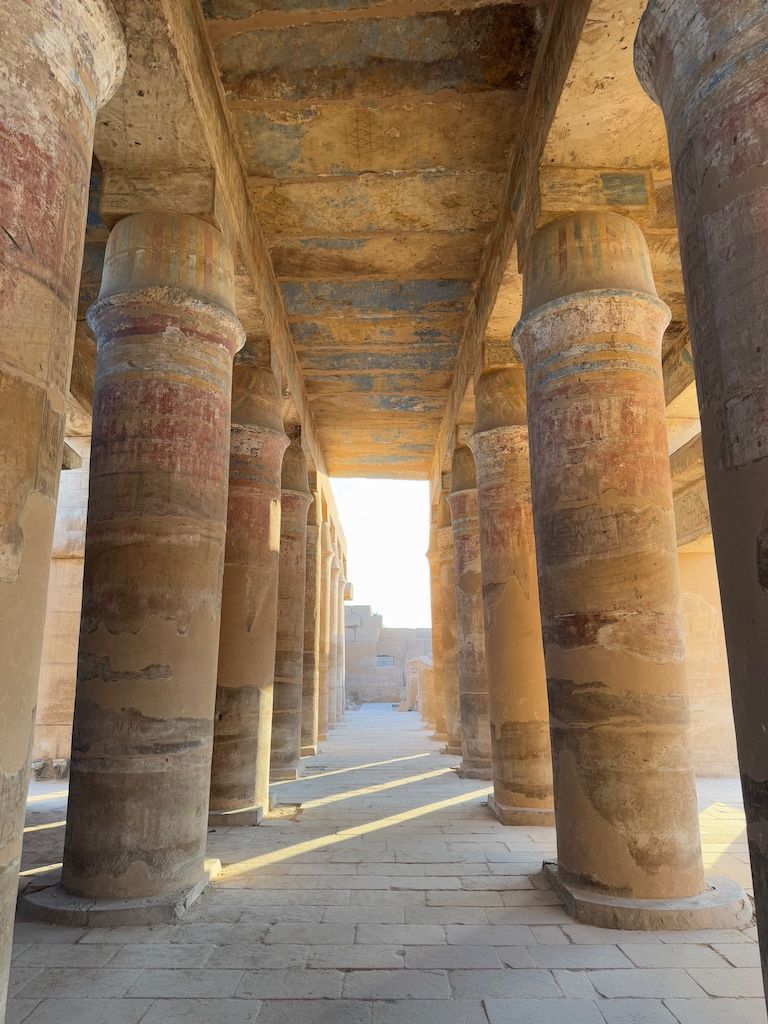
I arrived here thinking that after seeing the Great Pyramid, the Sphinx, the Temple of Hatshepsut, and the wall paintings in the Valley of the Kings, there was nothing left to impress me. I was wrong.
We left Karnak to arrive at the Luxor Temple right before sunset and stayed until after it was dark. The temple was conveniently located across the street from our cruise ship, so it was a short trip home for dinner. There is a mosque on the site that was built over a former Christian church, which in turn was built on the ruins of an ancient Egyptian temple. The Muslim call to prayer went out from the mosque just after we arrived, making for a magical moment.
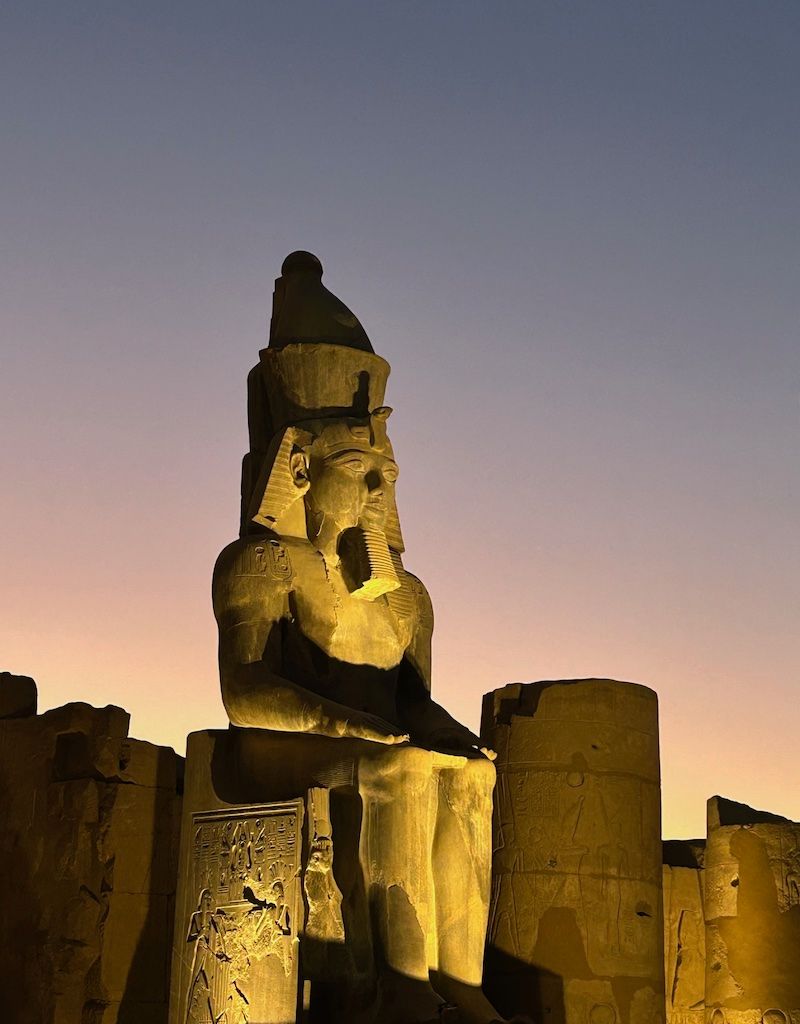
My photos didn’t quite do justice to Luxor Temple… but I tried.
Day 10: Luxor
In the morning we had breakfast and were shuttled to Al Moudira, a hotel outside Luxor in a mostly rural area. Within the grounds are gardens, a pool, an outdoor bar, restaurants, fountains, shaded seating areas, and more. It exudes high end design, with a style that blends Ottoman, Middle Eastern and North African elements. Kristin chose the hotel based on her passion for design, and we used this as a day off, spending most of it by the pool.
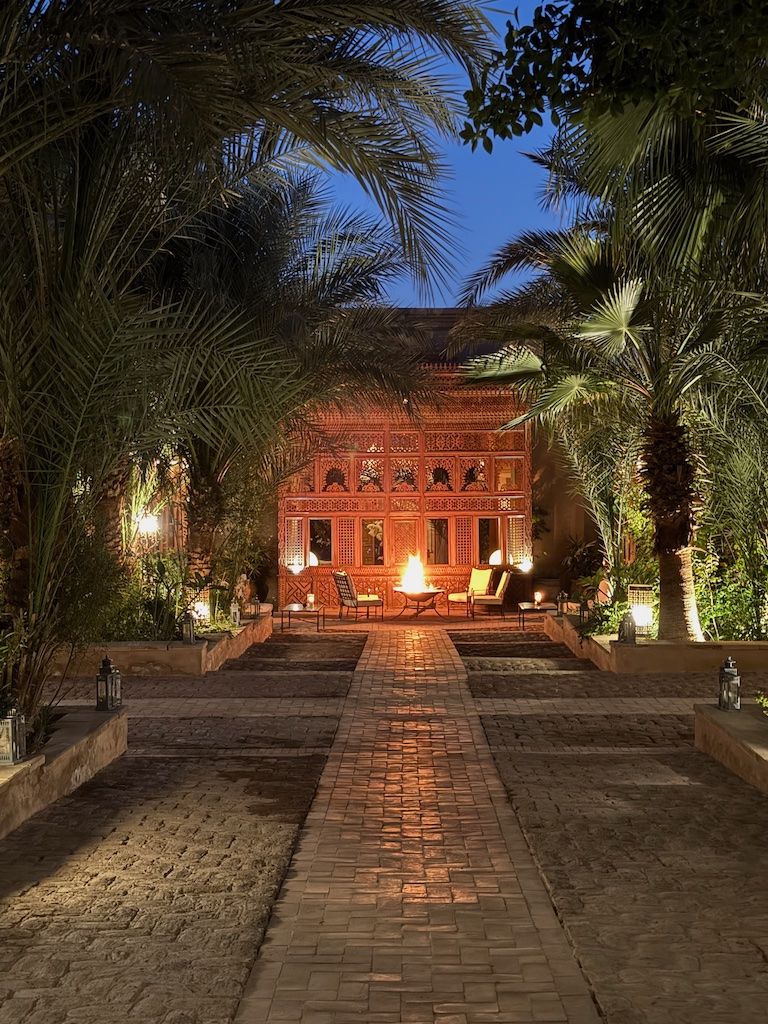
In the evening we sat by an outdoor fire and caught up with a couple from Houston we met at the Cairo Airport last week. They are on a group tour whose itinerary has somewhat overlapped with ours, and we ran into them at the Old Cataract, the Aswan Airport, Abu Simbel, Komombo, and then again at Al Moudira. In a country that gets 12M+ tourists every year, it is strange how many familiar faces we’ve seen at each site. But to be honest, I think their travel companions are beginning to think Kristin and I might be stalkers.
Day 11: Cairo
It was an early start this morning, with a 5:45 AM pickup at our hotel to transport us to the Luxor Airport for a flight to Cairo. We drove in the dark on rural streets before entering the more urban areas of Luxor, stopping at one of the many checkpoints along the way.
The security in Egypt has been an interesting experience. Periodically while on the roads you will run into these checkpoints, where men with guns ask your driver questions and record details about the vehicle’s passengers. These checkpoints usually have treehouse-like structures with small windows from which you often see the barrel of a machine gun. But in spite of this, much of the security here seems to be a bit performative - e.g. the metal detectors at sites always beep when I go through but no one stops me. The exception however is the airports, which not only check you thoroughly but put you through the same security twice.
After arriving in Cairo we were transported to the Four Seasons First Residence in Giza. We had a few hours of relaxation before meeting our guide Alia from Bellies En-Route, for a food tour in Cairo. Alia had only been a guide for four months, but made this experience a highlight of the trip, with great knowledge of each dish, including its history and role in Egyptian culture. I’m embarrassed to say that this was our first time walking through Cairo, and maybe more importantly, our first time crossing a street.
We did nine stops, skipping only one optional restaurant best known for fried cow brain. I didn’t pace myself well though, so by the time we got to the restaurant I wanted to visit the most - Abou Tarek for koshary - I was pretty full. Even then, it still was still a great stop.
Each place we visited was unique, with most having long histories in Cairo. For example, our stop to try Turkish and Arabic coffee was at a place owned by a gentleman in his 60s, who was the great-grandson of the original owner from 1914.
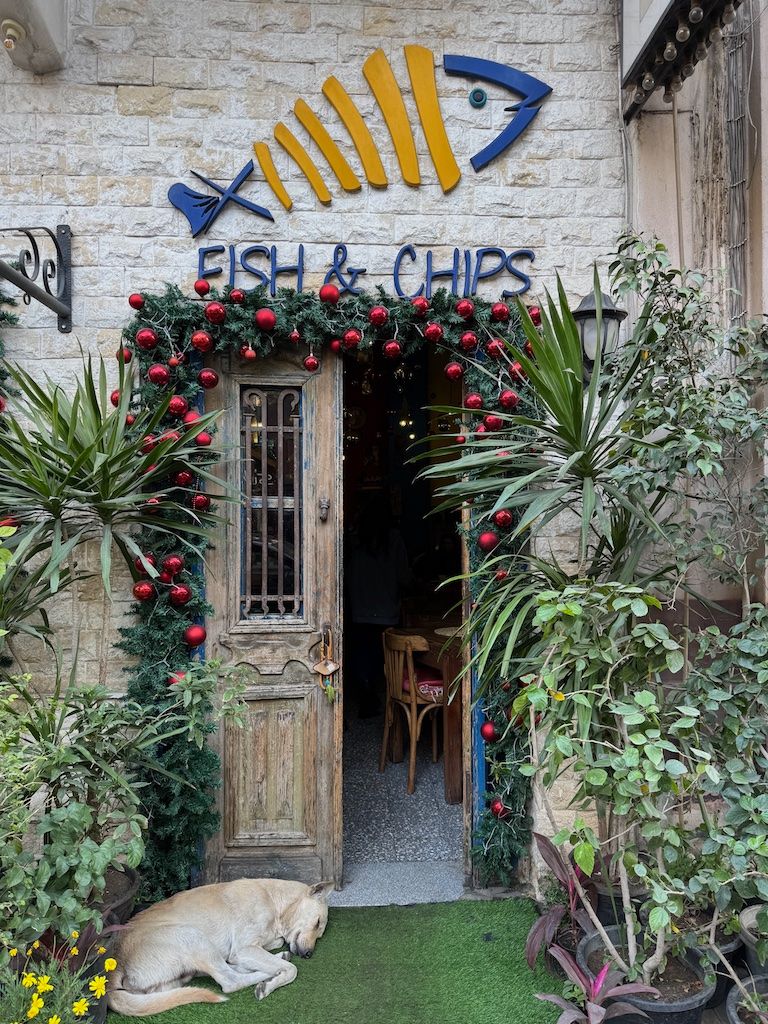
We tried ful, taamiya, baba ghanoug, fried eggplant, molokhiya, koshary, feteer, traditional home cooked vegetables, breads, fresh juices, pastries, and so much more. My favorite place for atmosphere was Fish & Chips, which had cats running all around, including a baby kitten that decided to use my back for a nap. But Abou Tarek was my favorite for food, since I have enjoyed Egypt’s national dish, koshary, multiple times now, and this place is considered the best in Cairo. We ended our evening on the roof of the historic hotel Carlton, where we had a drink and watched the sunset - a great ending to a great afternoon.
Tomorrow is our last full day in Cairo. Our adventure is finally coming to an end.
Day 12: Cairo
Our last day in Cairo started with our guide picking us up at the hotel to take us to the citadel on the Muqattam Hill. Unfortunately it was a smoggy day, so while we could see the Cairo skyline, we couldn’t see the pyramids. The fortress here was built by Saladin in the 12th century and completed by Muhammad Ali in the 19th. We visited the Mosque of Sultan Hassan, which was quite majestic.
Next we went to Old Cairo, which is inside an old Roman fortress, where we visited Abu Sarga, a church built on top of the caves that sheltered Mary, Joseph and Jesus during their exile to Egypt. Coptic is a Christian denomination affiliated with the Greek Orthodox Church. The Copts have very old roots in Egypt, with their oldest Church being built in the 5th century. In addition to being a religion, Coptic is a very old language that closely mirrors ancient Egyptian. After Abu Sarga, we visited the Hanging Church, the Ben Ezra synagogue, and the Coptic Museum.
The highlight of the day for us was the Egyptian Museum of Cairo. While we had already visited the Grand Egyptian Museum (GEM) in Giza, which is the largest in the world, the old Cairo museum was even better. It had the feel of an old 19th century museum, with precious artifacts packed on old wooden shelves and secured behind glass with rusting padlocks. We saw some incredible artifacts here, with our highlights being the Narmer Palette and the treasures of King Tut. Kristin actually teared up a little on seeing the golden mask.
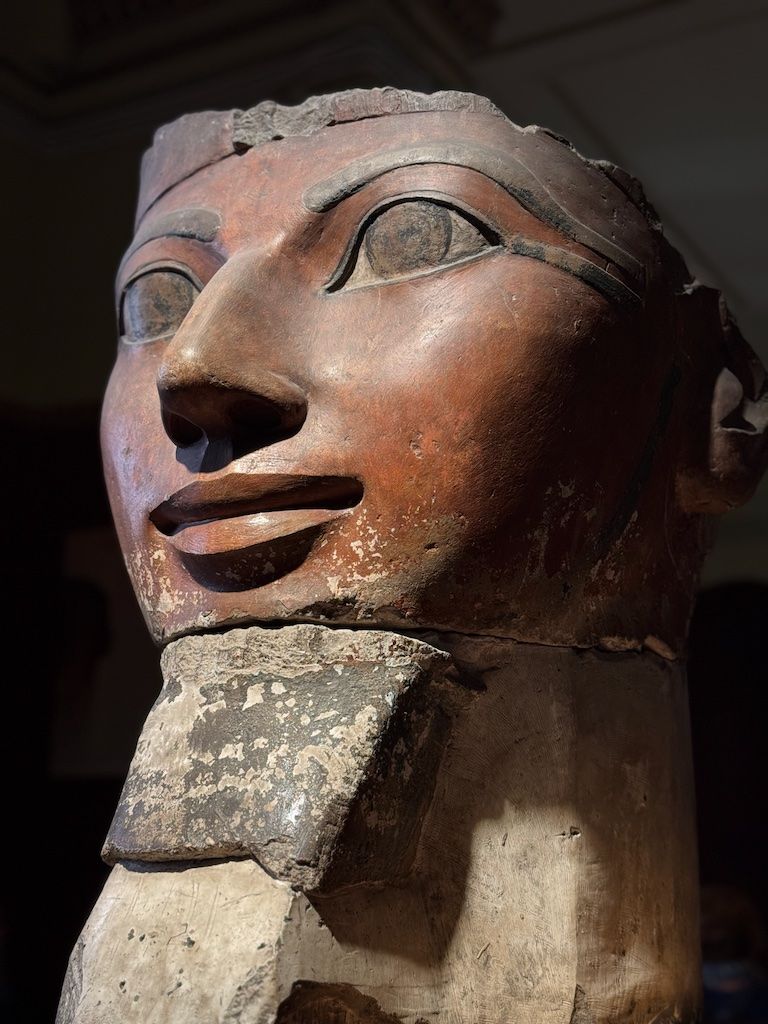
We stopped for a late lunch at Naguib, after which we walked down the historic Moez Street, and then into the Khan El Khalili bazaar, a labyrinth of streets selling everything from jewelry to spices to silks. We ended the day back at our hotel, where we are both looking forward to a relaxing evening.
If there is one thing I have not managed to get used to, it is the constant haranguing at the tourist sites from people wanting to sell you something. Many of the sites require that you walk through a bazaar, where sellers of everything from souvenirs to scarves to tunics swarm you. They also walk the grounds behind security at sites in search of tourists, and wait at where cruise ships dock to catch passengers coming and going. The result is that if you are not prepared, it can definitely take away from the experience of visiting Egypt. While having an Egyptian guide definitely reduces the approaches, even then it will still occur dozens of times per day.
The products being sold at tourist sites are typically cheap imports from China being marketed as Egyptian. Most sellers will let you go if you repeat “no thank you” several times in Arabic, but a few are very persistent. A common opening line is “where are you from?”, which serves three purposes: 1) engages you in a conversation, 2) determines how persistent they should be (US and Europeans get the most attention), and 3) helps them set an opening price.
In an environment where it is hard to stand out, one seller in the Valley of the Kings impressed me with his unique pitch. He was in his mid-70s but looked older, wore a traditional galabeya and keffiyeh, and had several front teeth missing. As he approached me he said: “I know you! Didn’t we go to school together? Don’t you remember me?” He then opened his arms like he wanted to give me a big hug and said: “You are my brother from another mother.”
For a moment he had me wracking my brain to remember if I had somehow forgotten that as a 17 year old I went to high school with a middle-aged Egyptian man.
Day 13: Boston
We flew out of Cairo airport in the early afternoon, making a connection flight to Boston in Zurich. It was a long and tiring day, but we arrived back home in the evening to find our cat George excited to see (Eben had stayed with him while we were gone).
If there are three things Kristin and I are looking forward to today, it is: 1) traffic rules, 2) not tipping to use a restroom, and 3) not being swarmed by people wanting to sell you things (“I don’t know what you want, but I have everything you need”).
While I’m looking forward to sleeping in my own bed tonight, it’s a little sad our Egyptian adventure has come to an end.
What Would We Do Differently
We've never taken a trip without coming home with a short list of things we might have done differently. Don't let my list diminish the fact this was an incredible trip. But while the experience is still fresh in my mind, here are the things that with hindsight we might have changed:
#1: Skip the Cruise
Most of the articles I read highly recommended incorporating a cruise into the itinerary. The advantages to cruising include convenience to some sites, the scenic experience of being on the Nile, the inclusion of guided tours, the all-inclusive amenities, and the social aspect of traveling with others. Some of the disadvantages include cost, being on a fixed schedule, the inability to go off-the-beaten-path, and the fewer amenities of a cruise ship versus a hotel.
We started our research thinking of doing a 9 day cruise on the Nile, and ended up including 4 days / 3 nights of cruising into our itinerary. While we enjoyed the cruise, in the end we felt we could have skipped it all together based on the fact we really liked our hotels in both Aswan (Old Cataract) and Luxor (Al Moudira). We also didn’t like being on a fixed schedule, especially around dining times. But at its core, there are no cruise amenities and accommodations that can compete with a great hotel (unless of course you are specifically looking for a unique cruising experience, like the Steam Ship Sudan).
While to cruise or not is a personal preference, if you do it, I would limit the trip to no more than 3-5 days. The distance from Luxor to Aswan is only 150 miles, so the only way to do this over 9 days is to spend multiple nights in the same location. This will likely result in your ship being docked side by side with other ones, often resulting in your Nile view looking directly into the cabin of your neighboring ship (and sometimes with the smell of exhaust wafting in).
#2: Stay Longer at the Old Cataract & Al Moudira
The Old Cataract in Aswan combines Old World charm with all the modern amenities you want in a luxury hotel - e.g. a pool, spa, sauna, multiple restaurants, an outdoor terrace, and more. The staff is outstanding, the views magestic, the rooms spacious, and the experience everything you want from a hotel in Egypt.
Al Moudira in Luxor exudes high end design, achieve a look that feels but engaging and authentic. One of our favorite experiences of the trip was spending an evening sitting by an open fire on the grounds with a glass of wine.
We stayed two nights at the Old Cataract and one at Al Moudira, and both were exceptional. Our biggest regret? Not adding another night or two at each hotel.
#3: Don’t Miss the Old Cairo Museum
There was a time many years ago where most of the artifacts displayed to the public were shown at the Egyptian Museum in Cairo (a.k.a. Old Cairo Museum). With the opening of the National Museum of Egyptian Civilization (2021) and the Grand Egyptian Museum (2024), these artifacts are now scattered between three locations. Our original itinerary had us going only to the GEM, but as we toured Giza, Saqqara and Memphis, we regularly asked our guide where we could see a specific artifact and the answer almost always came back: “The Old Cairo Museum”.
By the end of the trip we decided to add a guided tour of the Old Cairo Museum to our itinerary. While we enjoyed the GEM, it didn’t compare to the experience of the Old Cairo Museum. In addition to having artifacts that can be seen nowhere else - e.g. King Tut’s treasures, the Narmer Palette - it had a vintage charm that made you feel like you were walking through a late 19th / early 20th century museum, from which Howard Carter might suddenly appear from around the corner.
#4: Bring Small Denomination USD
Egypt is the first country I traveled to where I could exclusively use US dollars. This is particularly convenient because it means you never have to change money. I went to my bank before leaving and brought what I thought would be enough cash for the trip in $1, $5, $10 and $20 denominations. Once in the country, I quickly learned that any bill greater than $10 is hard to use for tips and small purchases. With hindsight, I should have brought exclusively $1s and $5s. Also make sure none of your bills are ripped in any way or they often won’t get accepted at many places.
#5: Mentally Prepare For the Constant Sales Pitches
Egypt’s heavy reliance on tourism has resulted in one of the most in-your-face approaches to making money from visitors I have experienced. If you think you will be able to go to Giza and quietly take in the grandeur of the pyramids, you will be sorely disappointed. As you enter a historic site, you usually pass through a bazaar, in which sellers try to push their goods on you. After getting through the bazaar, you will go through security and enter the site, where you will encounter more roaming sellers. If you have to use a restroom, you should expect that an “attendant” will have removed all the paper towels and toilet paper, forcing you to provide them with a tip. You will also regularly encounter armed security guards who wave you over as though you did something wrong, where they will proceed to show you something or offer to take a photo, with the expectation you will tip them. There are countless more ways you will be approached, too many to detail here. I will confess there were a couple moments where this all felt a little overwhelming, but I fortunately bounced back.
We reminded ourselves regularly that these were just hard working people making a living. One of our guides said that tipping is a way for tourists in Egypt to show appreciation, which helped us put it in a little more cultural context. But you should prepare yourself in advance for this constant haranguing, and have a strategy for managing it so it does not negatively impact your overall experience.
#6: Prepare for Haggling
We were surprised to learn from one of our guides that haggling is mostly reserved for places that cater to tourists, and is generally not a part of the day to day life of most Egyptians. While we got the hang of haggling on our trip, it came only after making an expensive mistake on an “educational tour” at a papyrus shop. Unfortunately businesses that make money from tourists have many techniques to get the best of them - e.g. listing prices as fixed, acting like there is a discount off fixed prices, saying there is no haggling. The reality is any place associated with tourists is selling their items at 2X+ an actual acceptable price. Your job as an interested buyer is to determine what you are willing to pay, and negotiate until you get it. One of the best haggling techniques is of course walking away. If the seller lets you go, you know you went below his or her acceptable price.
I should also mention that we were not prepared for the “education tours” every tour guide seems to incorporate into their tours. During our private tours, we were regularly brought by guides to places that made everything from papyrus, to alabaster, to fragrances, to rugs. It seems as though the guides have some deal with their chosen businesses where they get some kickback on bringing tourists there. The typical “educational tour” experience is to show you how something is made, get you coffee, let you use a clean bathroom, and then try to sell you things at highly inflated prices. Based on online reviews, we’re pretty sure the workers we saw making products outside the alabaster shop we visited near the Valley of the Kings were not actual skilled alabaster workers but there just for show.
While I understand that Egypt is a tourist economy that is looking to extract every dollar they can from their visitors, I just wish it could be done with a little more honesty and transparency. So when you find a product that interests you, don’t assume it is made at the store just because they tell you it is - and realize it may not even be made in Egypt at all.
#7: Do a Food Tour Upfront
We did our food tour in Cairo at the end of our trip. This tour was one of the highlights of our trip, and our only regret was not doing it at the start to allow us to better take advantage of Egyptian cuisine during our travels. Egyptian cuisine is widely varied and incredibly tasty, using lots of local fresh fruits and vegetables that are available year round.
#8: Be More Adventurous on Restaurants
We mostly ate at hotels, which had generally good food but nothing like what we experienced on our food tour. A few of our guides suggested places to go for authentic Egyptian food, but we never made it happen. For example, when we were in Aswan, our guide recommended we go to El Dokka for dinner, which was a very short boat ride from the Old Cataract (you could practically swim to it). If I could do it over again, I would have done more research on authentic Egyptian restaurants and skipped meals at the hotels.
Last Thoughts
Did Egypt live up to our incredibly high expectations? Absolutely. If this is a must-see destination for you, I can only say: just do it.
